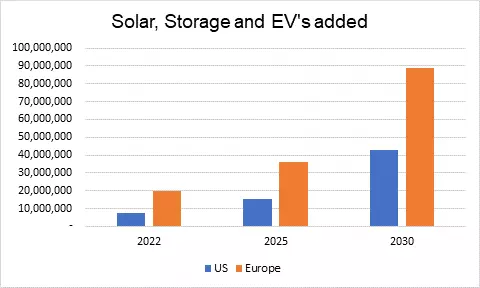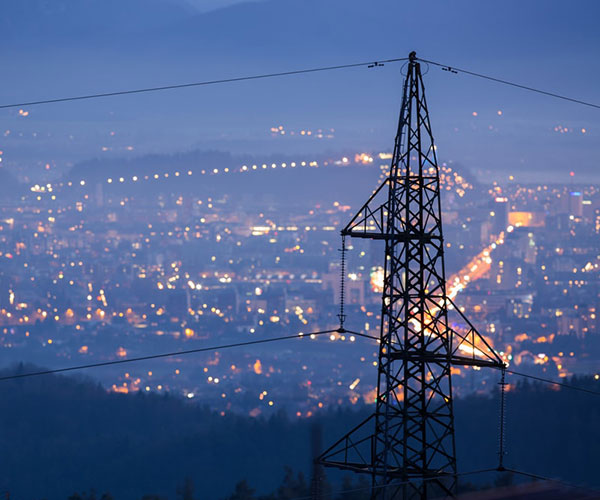- The global transition to renewable energy will need artificial intelligence (AI) technology to manage decentralized grids.
- AI can balance electricity supply and demand needs in real-time, optimize energy use and storage to reduce rates.
- Technology governance will be needed to democratize access, encourage innovation and ensure resilient electricity sources.
One month after historic and deadly winter storms left millions of Texans without power, many energy experts, politicians and pundits have called for massive spending on grid-related infrastructure upgrades. Improvements to infrastructure in the US and elsewhere are long overdue, but it’s time to explore better options to ensure reliable, low-carbon electricity.
Calls for government spending on grid infrastructure to update long transmission lines from a centralized power generation source attempt to solve today’s problems using technology from the past. There is a better, more forward-looking alternative already in existence: Artificial Intelligence (AI) that leverages decentralized renewable generation sources.
Renewable energy increases complexity
As we move toward an increasingly electric world, more energy will be produced by decentralized, renewable sources. Think microgrids, wind farms, private solar panels, and batteries.
Welcome as they are from a sustainability point of view, these will add complexity to energy grids across the globe. Over the next 10-15 years, the growing adoption of electric vehicles, the electrification of heating systems, and the proliferation of distributed energy resources (DERs) like wind turbines and solar panels will require a delicate balancing act to match supply with demand without collapsing the grid.
Take Australia as an example. BloombergNEF projects solar energy to be present on 30% of the country’s residential, commercial and industrial buildings by 2030, and 60% by 2050.
A similar scenario is playing out in many other parts of the world as businesses, government and residential consumers increasingly produce their own energy through solar panels, storing that energy in batteries and electric vehicles, or feeding it back to the grid. According to our forecasts (see figure below), approximately 36 million assets such as solar panels, electric vehicles and energy storage will be added to the grid in Europe in 2025, and 89 million by 2030. Millions of individual devices uploading and downloading electricity could create chaos for electric grids.

Image: Schneider Electric forecasts
In other words, reliance on a central utility to produce and transmit electricity is fading, and utilities will need to shift their business models. Soon, they will no longer be the sole source of energy, but will be needed to maintain a balanced grid, shifting electrons from disparate sources and storage systems to seamlessly deliver energy where it is needed second-by-second.
AI will balance millions of assets on the grid
With the help of AI software, decentralized energy sources can send any excess electricity they produce to the grid, while utilities direct that power to where it’s needed. Similarly, energy storage in industrial facilities, office buildings, homes, and cars can hold excess energy when demand is low, while AI deploys that power when generation is inadequate or impossible.
That’s a lot of moving parts requiring coordination, forecasting and optimization to keep the grid in balance. If you think of DERs as individual musicians, a utility is a conductor keeping the orchestra in sync as AI composes the symphony in real-time.
This makes an AI-centered system a potential game-changer. Shifting from an infrastructure-heavy system to one centred on AI enables forecasting and control in seconds – not days – resulting in a grid that is more resilient and flexible when unforeseen events occur.
All this means that utilities, policymakers and regulatory bodies need to start thinking about what role they want to play when it comes to decentralized energy resources. The patchwork of distributed energy producers will depend on coordination and management. Utilities can take the lead here as they face a shrinking pool of customers purchasing electricity as more homes and businesses become energy producers themselves – thanks to rooftop solar panels and the like. Already, the size of a median power plant in Europe has fallen from 800 megawatts in 2012 to 562 megawatts in 2020, and BloombergNEF projects this will plummet to 32 megawatts by 2050.
Utilities will have to decide if they are working with software companies, or if they want to become software companies in their own rights. These advancements require a shift in thinking from legacy models of capital investment in a few large energy generation assets to demand management of an exponentially growing number of privately owned assets – all while protecting customer data and privacy and ensuring the cybersecurity of grid management.
National and local governments also will have to both accelerate and rethink their approaches to infrastructure spending and to energy generation and transmission infrastructure in particular.
Infrastructure-based solutions to maintain grid stability require years of planning and construction, and billions of dollars in spending. The current economic backdrop and lengthy political debates like the one expected in the US are likely to slow needed investments – but climate change will keep bringing more extreme weather around the globe, so there is no time to waste.
Investing in centralized grids, with their system of long wires and transformers, is the wrong way forward: instead, governments need to plan for a grid where communities and buildings generate their own electricity, managed in real-time by software.
Policymakers should consider public financing of renewable energy generation and incentives for more distributed energy generation in homes and private industry. And we need globally accepted governance of AI software to ensure interoperability, transparency and equal access across the energy landscape.
The events in Texas laid bare how vulnerable our current electric grids can be. Just as we shouldn’t be trying to build a better internal combustion engine, we can’t afford to rebuild the grid of the past. AI and software are key to a more sustainable, all-electric world, and the solution for the grid of the future.
—
This material [article] was written by Emmanuel Lagarrigue, Executive Vice-President, Chief Innovation Officer, Schneider Electric.
It was published by the World Economic Forum.















Comments